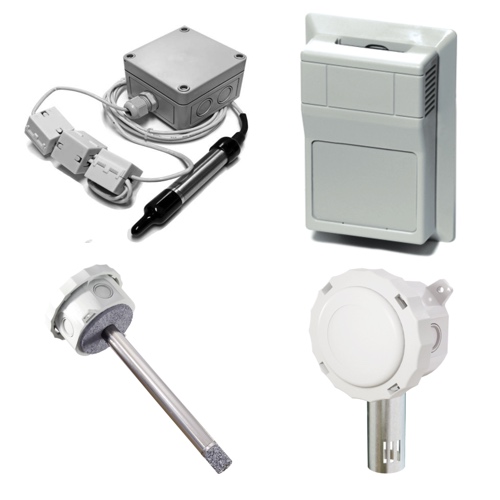Humidity Sensors

Humidity sensors are used to measure the amount of water vapor present in the air, providing critical data for environmental monitoring and control systems. RSP Supply carries a full line of humidity sensors designed to measure relative humidity and, in some configurations, absolute humidity, temperature, or dew point. These sensors are commonly used in industrial facilities, HVAC systems, cleanrooms, laboratories, storage areas, and agricultural environments where moisture control is essential.
High-performance humidity sensors are engineered for accuracy, stability, and repeatable performance across changing temperature and moisture conditions. By continuously monitoring humidity levels, these sensors enable automated systems to regulate ventilation, cooling, heating, and dehumidification processes. This helps maintain consistent environmental conditions that protect sensitive equipment, preserve product quality, and improve energy efficiency.
Humidity sensors are available using different sensing technologies, including capacitive and resistive designs. Capacitive humidity sensors are widely used due to their broad measurement range and long-term stability, while resistive sensors provide reliable detection through changes in electrical resistance caused by moisture. Selecting the appropriate sensor depends on accuracy requirements, environmental exposure, and application-specific performance needs.
More Information about Humidity Sensors
In high-performance applications, humidity sensors are calibrated for accuracy and stability, which allows them to perform consistently in warm and wet-to-dry environments. These devices are used to monitor humidity levels in cleanrooms, storage facilities, greenhouses, and laboratories. By enabling systems to automatically adjust ventilation, air conditioning, or dehumidification functions, these same sensors contribute to better comfort, product quality, and energy efficiency. The ability to continuously measure the water vapor content in these dynamic environments gives the sensors an important role in maintaining the balance of temperature and humidity.
FAQs
Q: What is a humidity sensor, and what does it measure?
A humidity sensor measures the amount of moisture in the air, typically reported as relative humidity (RH). Some sensors also measure temperature or dew point to support environmental control systems.
Q: What are humidity sensors commonly used for?
Humidity sensors are used in HVAC systems, building automation, manufacturing, cleanrooms, data centers, agriculture, pharmaceuticals, food storage, and other environments where moisture control affects performance or safety.
Q: What types of humidity sensors are available?
Common humidity sensor types include capacitive, resistive, and thermal conductivity-based sensors. Capacitive sensors are the most widely used due to their accuracy and stability.
Q: How accurate are humidity sensors?
Humidity sensor accuracy typically ranges from ±1% to ±5% RH, depending on sensor quality, design, and operating conditions.
Q: Do humidity sensors require calibration and maintenance?
Yes, periodic calibration and inspection are recommended to maintain accuracy and detect sensor drift or contamination over time.
Why Buy Humidity Sensors from RSP Supply
RSP Supply offers a reliable selection of humidity sensors designed for precise environmental monitoring in industrial and commercial applications. Our products support accurate humidity measurement, system efficiency, and long-term reliability. Customers rely on RSP Supply for technically sound sensor solutions, knowledgeable support, and dependable sourcing for environmental control components

